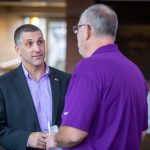Jerome Twyman likes things on his own terms. A heart attack was never in his plans. Life has a way of throwing even the most disciplined batters a curveball, however, and one morning in August 2023 while enjoying his normal morning routine of errands in his hometown of Keyser, West Virginia, Twyman was hit hard with telltale symptoms.
“I had just sat down in the barber shop to wait for a haircut when I started sweating buckets,” he said. “Then I felt it in my left arm, and I knew right away I was having a heart attack.”
It was about 25 minutes by ambulance to the UPMC Western Maryland emergency department, and though concerned, from the start Twyman had faith that whatever care lay ahead for him would work out positively. “I said ‘I’m not going out like this, are you kidding me?’ I have plans and I’m not done.”
He had no way of knowing at the that his case was something his doctor had only ever read about in a textbook.
The interventional cardiologist on call that day was Dr. Hani Alkhatib, director of the structural heart program at UPMC Western Maryland. Twyman presented to the emergency department with a massive heart attack resulting from clots travelling from the heart chambers into all the main heart arteries and eventually impeding blood flow. After examining him and reviewing images of his heart, the complexity and severity of the case became clear.
“Mr. Twyman was born with an extremely rare congenital anomaly affecting his heart vessels, which was not recognizable until our encounter with him,” Alkhatib said.
The condition, known as anomalous left main coronary artery originating from the right coronary cusp, is a one in 400,000 diagnosed birth defect. “Normally the heart has two main vessels with separate origins arising from the aorta, but in his situation, both arteries shared the same origin which made him susceptible to a devastating and life-threatening complication.”
“A heart attack of this kind is extremely rare and tremendously challenging given the patient’s anatomy,” Alkhatib said. “Heart attacks typically occur because of blockages caused from a cholesterol plaque forming on the inner lining of heart vessels. Mr. Twyman’s congenital coronary artery anatomy resulted in the clot travelling to all his arteries, and this became an event that neither myself or any of my Interventional and cardiology colleagues had ever seen.”
As a result, a routine procedure that would typically take 30 minutes to complete took in excess of three hours. “With the superb effort and resilience of our cardiac team we were able to aspirate all the clots out and reopen his arteries using stents and balloons, and we were able to perform this complex procedure in a timely manner, which is a huge factor in having a positive outcome,” Alkhatib said. “I give Mr. Twyman a lot of credit. He was hanging for his dear life and didn’t give up for a second, which helped us a lot to keep going and do what we needed to do.”
After three days of recovery, Twyman was able to go home full of appreciation for the specialized care he received. “You have to understand something about me and about my family,” he said. “We don’t like to bother anybody. I don’t like asking for any help. We don’t like relying on anybody. That used to be my motto. When I got myself into trouble, I would figure out how to get myself out of it. I am not that way anymore, and especially not with this.”
Going forward, Twyman has his cardiac health at the front of his future plans. “Dr. Alkhatib is a very concerned, thorough doctor. I have him on speed dial now. If I need to call, he takes time for me. I know I can ask him anything because I never feel like I am bothering him. There was something different about my treatment and the care,” he said. “I didn’t have any worries. I just knew this hospital was on point. I don’t have many words. I knew I was going to be all right.”
Twyman’s case is just one of many success stories to come out of the UPMC Heart and Vascular Institute at UPMC Western Maryland. “I really want to commend our cardiac team,” Alkhatib said. “They are reliable and highly experienced and deal with all sorts of situations. Their dedication to save lives in this community is outstanding.”
Journalists interested in learning more can contact mediarelations@upmc.edu.









